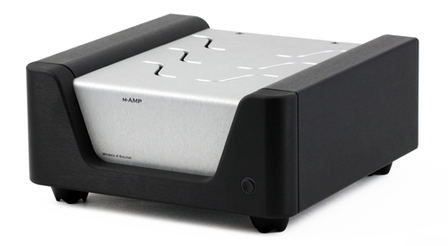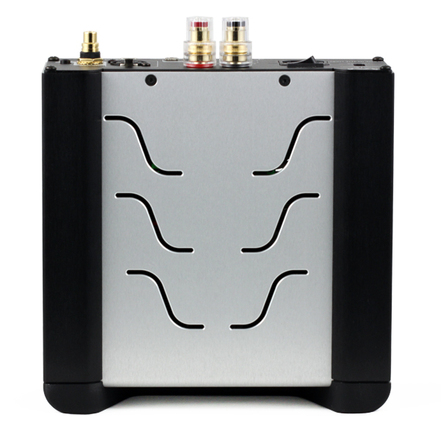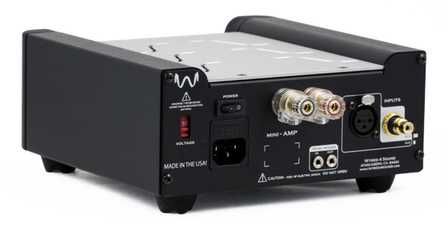|
|
You are reading the older HTML site
Positive Feedback ISSUE 69
wyred 4 sound mAmps as reviewed by Francisco Duran
Tube amplifiers have appealed to me for many years. The primary reasons being the way they reproduce the harmonics and tone, and texture of the music. Yet there are designers who say that a competently designed amplifier whether tube or solid-state should be sonically indistinguishable. Hmm! I can see the torches being lit and hear the implements being handed out to the local citizenry. It would be wrong for me to generalize on the sound of either of these two technologies. I have heard some very nice and musically accurate examples of both types of amplifiers. Yet each design has their respective strengths and weaknesses. And I have my own biases. Now I am going to go out on another limb with another statement worthy of lynching from the old guard audiophile community. It took listening to a good Tripath amplifier in my system for me to realize what I didn't like about solid-state class AB amplifiers. For the most part, they are not that musically exciting. Again I have heard some very nice and musical examples of the genre; in fact I think I happen to own one. But the bottom line and when all of the audiophile filigree is removed, I have had more fun listening to music through my NSMT modified Lepai Tripath amplifier than I have had from just about any other solid-state amplifier—the Lepai amp is a class D amp that costs around $100, give or take depending on which power supply you choose. Notice I said fun. I am not thinking about a list of audiophile catch phrases when listening to it. Does this negate all of the positive things I have said in past reviews of class AB amplifiers in the past? Read on. Boy this limb is getting smaller! Enter the Wyred4sound mAmp mono block amplifiers. Solid-state, yes, Tripath, no! These are ICEpower class D mono block amplifiers. What is ICEpower you may ask? Please Google ICEpower and Karsten Nielsen for a comprehensive look at this fascinating technology. Wyred4sound are using the "latest generation of the ICEpower technology with a completely redesigned input stage". This amplifier is designed with so many features that listing them all would sound like the instruction manual. There are balanced and unbalanced inputs, dual differential input stage, audio grade capacitors, and 14AWG OFC wiring. Aside from the audio grade capacitors and the quad parallel front end which is said to help reduce noise, the front panel of the chassis is made from a solid piece of 3/4" aluminum that is line grained and anodized black. The rigid structure and vented top make a chassis that is said to be immune to "frequencies and vibrations" and allows heat to escape from the top vents, although these units generate little heat. Power output is 255 watts at 8 ohms at 0.2%THD+N and 430 watts at 4 ohm at 0.2% THD-N. Personally I find the looks of these amps to be very nice in a kind of modern/retro way. The set I was sent are a nice looking black and silver. They also come with a very interesting set of feet. A power button on the front right of the faceplate with a ring around it turns green in standby and blue when fully turned on. There is a comprehensive and straight forward manual packed with the amps. Indeed the advantages of ICEpower class D amplifiers are many. Amplifier efficiency, smaller amplifier chassis with no heat sinks which reduce manufacturing costs. They are cool running and class D technology is at the beginning of its development. Wyred4sound have taken this technology and implemented their own design concepts to create products able to compete in an ever growing class D field in the high end industry. Wyred4sound products are designed and manufactured in the USA. Part of the reason I took so long to get this review out is that my system has changed, at least the critical parts. I went from my Tonian Labs TLD1 floor standing speakers to the Fritz Grove speakers. These are two different design philosophies but some of the principals are similar. The Tonian's are very efficient but the Fritz' are too. This is proven by the fact that they can be driven by my lowly NSMT Lepai very low watt Tripath amp to loud levels without distortion and quite nicely I might add. So time was needed to acclimatize to this new stand mounted speaker. Consequently speaker wire and interconnects had to be changed around and experimented with. This takes time. It didn't help that my reference amplifier, the Marantz PM15S1 with the Signature modification by the Upgrade Company, didn't quite gel with the Groves as much as I would have liked. Another reason I was late has to do with my day job. but we will leave that one alone here. I used my Marantz SA15S2 SACD player, also with the signature mod by TUC, for spinning CD's. How old fashion of me! I used my usual Kuzma Stabi/Stogi/Maestro with the phono section from the Marantz PM15S1 and a borrowed Grahm Slee Gram Amp 2SE moving magnet unit for spinning vinyl. How ancient of me! Actually the Marantz amp was kind of deceiving. The preamp section worked better when used with the mAmp monoblocks than when running just the Marantz integrated with the Fritz's. Actually, a friend of mine favorably compared the preamp section of my PM15S1 to his E.A.R. 834 tube preamp. I also used the inexpensive but quite nice Audio Limits passive line stage. The best combination of wire I found for the equipment above was a pair of Soundstring speaker cable and Analysis Plus Solo Crystal Oval interconnects. I broke in the mAmps for over three hundred hours before getting down to serious business. If ever there was a real world situation to place a pair of amplifiers such as these in this would be it. I feel I have very good performing components, but ones that are not insanely priced. Actually, I can't afford insanely priced gear. And really if I could, that system would have to sound incredible before I would fork over a boat load of cash. I have heard a few top priced systems that justify their prices... sound quality wise. Either I don't hang out in the right audio salons, or my auditory and monetary priorities are different than a rich guy.
You may or may not have read certain things over the last few years about the sound quality of class D amplifiers. Before my foray into the Tripath amps I was also a bit skeptical of the sound quality. I have read about the bright and thin sound, the lack of air, and the less than perfect soundstage. Well all of those notions simply faded to the ether as soon as music was played through these well broken in Ice module amplifiers. After all, this is the third generation of the Icepower module that Wyred4sound uses in their construction. And let's face it, Wyred4sound's track record is nothing to sneeze at. The combination of mAmps and Fritz Groves was amazing. I liked it immediately, and not in audiophile terms, but in the way that combination made it fun to listen to music. After giving my less than stellar opinion of class AB solid-state amplifiers in the first paragraph, I forgot to mention that they are mostly heavy, inefficient, and often expensive beasts. I just got back from the chiropractor today and believe me, my heavy amp lifting days are numbered. Here was a pair of amplifiers which I could hold in my hands without strain, that were powerful, very efficient, and didn't heat up a small room. The sound quality proved to be the antithesis of bleached, bright, etched, or thin. They have a high degree of resolution, yet sound clean, natural, and smooth. They are dynamic and able to portray delicate dynamic contrasts with ease, without sounding grainy or smeared. Bass sounds right, tuneful, and not overly tight. Their soundstage capabilities are spacious, precise, and dimensional without sounding exaggerated. I hear no buzzes or hums while they are on. They easily showed differences in components, wire, and recording quality, yet do not sound fatiguing. One artist that I hold in high regard is Pat Metheny. I have been a fan for many years with one album of his that is a true favorite of mine: Letter From Home. When you have a piece of music that you feel is a timeless classic, you sometimes fail to realize just how old that music is. This album sounds as fresh to me now as the day I bought it—it was released in 1989. On it you have Pat Metheny's intricate and dynamic guitar playing, Lyle Mays keyboard finesse, and Pedro Anzar's delicate and soothing vocals. On track 8, "Dream Of the Return", the mAmps tracked the dynamics of the synth guitar with ease. The spacious stage reveals a shaker floating left of center. You hear excellent detail retrieval as drummer Paul Wertico gently hits the cymbals. But it is Pedro Anzar's vocals that sound oh so captivating as he croons some of the most beautiful lyrics in pop music. Here is a portion of the lyrics.
It sounds even more romantic in Portuguese, as it is sung on the CD. Anzar's vocals sound very natural as he laments about what I think of as lost love. The timbre of his voice sounds true. Then just when you have been lulled into musical bliss you are jolted out of it with track 9 whose sharp percussive details are all over the soundstage. Then bass and drums kick in with a tight sound as full and deep as the Fritz Groves could go. There was no lagging of timing between the synth guitar, percussion, drums, and piano. There was great transition from the almost cacophony of track 9 to the smooth and sultry track 10; "Are We There Yet". This track has more vocals from Pedro Anzar... but this time in more of a tribal nature a la The Emerald Forest soundtrack. Again the timbre and tone of his vocals sounded natural, timing is spot on with very good detail retrieval and natural dynamic shadings.
Another album I pulled out to focus on vocals and two songs in particular are "Crazy" and "Lonely Street" from Willie Nelson's Milk Cow Blues. After listening to the whole album all the way through, I went back and took notes. This is the best I have heard this album sound in any of my systems. The spaciousness and tone of the vocals and the taut dynamics translated to a very musical listen. The last part of the song "Crazy" showcases the dimension and depth of space, and sweet extension in the treble when the cymbals are gently hit. The texture in Willie's voice at the end of the song when he sings "Crazy for loving you" is stunning in the way it is fleshed out. There was nice full solid bass in track 8, "Wake Me When It's Over" and the reverb in "Lonely Street" wasn't in the recording, it was in my den. Going back to 1996 with Ginger Baker's CD Falling Off The Roof the mAmp's portrayed Charlie Hayden's bass as what it is: a wooden hollow body instrument. Baker's drums were given the same treatment. Pace and timing were spot on and dynamic shadings were very good especially with this recording where some of the tracks or part of the songs are played with finesse by these expert craftsmen. The bass was reproduced full and taut on this CD but not as tight as I believe it should be in the lowest reaches especially from the acoustic bass. I have to put the blame on the Frits Groves. I have heard of this criticism about Fritz speakers before although the anomaly is not real serious. To the Fritz Grove's credit, they are the kind of speaker that, for most of the time, you don't need a subwoofer. They reach pretty far in the bass region for stand mounted speakers, so I guess some compromises had to be made. Again the mAmps were showing the character of the ancillary components with ease. Playing all of my disc's, whether vinyl or plastic, is important to me... and not just a select few of the best recordings. If a system can't play my poorly recorded disc's half way decently, then we have a problem. To see how well the mAmps could handle badly recorded discs, several were played on both my CDP and record player. These discs were only stinkers in recording quality, but not in musical content. I went through several Pretenders CD's several Stones LP's and CD's, and The Damn Yankees just for good measure. The mAmps didn't pretty up these releases, but neither did they make them sound worse. I still enjoyed the music while cringing on the bad parts. I guess that is why they make tone controls. Running them through my Margules U280SC tube amp gave similar results. But when I ran these same titles through my Marantz PM15S1, I noticed to my surprise that it was indeed prettying up these recordings a bit and the overall sound was definitely smoother. Any component in my system is going to get a fair share of movies ran through it. It was fun watching movies through these amplifiers due to their strong sound staging capabilities. A two channel system is not going to give you as clear and intelligible dialog as one with a dedicated center channel. But the mAmps fared very well with dialog from movies. It is hard for a die-hard two channel guy to make the move to a five channel system. But I can imagine that a system with five or seven of these little amplifiers would make a formidable surround system. Comparing my Margules U280SC to the mAmps proved interesting. Here is a $3500 all tube amp running 4 KT-88's with four 12AU7 signal tubes. My tubes are new stock and not NOS—they are a complete set of J&J's. I listened to the same music as I mentioned above for the comparison. The Margules definitely sounded a little smoother and slightly darker. Images were very clean and well carved out. The soundstage was very dimensional yet not as 'lit' up if... you will. The Margules has very good transient speed but is a bit laid back or relaxed overall. Inner detail is very good but the mAmps sounded a bit cleaner and precise. Notes faded out very smoothly and this aspect of the tube amp's sound was very appealing. The piano on the last track on the Metheny disk sounded very good on both amplifiers. But with the Margules you got that extra bit of harmonics at the trailing end of the piano notes. This is the aspect of tube amps that really draws one into the music. Overall the bass on the Margules was fully extended and taut, but a bit less sharp. The mAmps countered with sharper transients a little faster speed... and are the more exciting sounding of the two amps. With its clean, wide, and deep soundstage, the mAmps don't know they are solid-state amps. The great strength with the mAmps though is that these qualities are never exaggerated. Overall both amps worked very well in my system. I could listen to either one for hours. Could the mAmps be bettered? of course they could. With things like better tonal color, harmonics, and unbridled dynamics, the sonic ante could definitely go up. But of course one should expect to pay quite a bit more for such improvements. I wasn't in the audio game when transistors were new to the scene and all the rage... replacing tube amps faster than last week's news. Solid-state amplifiers have come a long way since then. The same could be said for class D technology. This technology may not be in its infancy, but if it is still developing we are in for some pleasant audio surprises. In the past I have read about the negative aspects of class D sound. That was then, this is now. I worked hard to find the so called negative traits in these class D amplifiers. If there were any in these amplifiers, I could not find 'em. At least not any that were an impediment to the music. In fact, music played through these amplifiers was very inviting and exciting. I greatly enjoyed music through my system with these amplifiers. They even kept pace with my twice as expensive tube amp. The fact that they are lightweight, efficient, and affordable is only icing on the cake. I can definitely add the Wyred4sound mAmp mono block Icepower amplifiers to my list of fun solid-state amplifiers. They just happen to be class D amplifiers. Needless to say these amplifiers are highly recommended. Francisco Duran
mAmp amplifier
Wyred 4 Sound |











